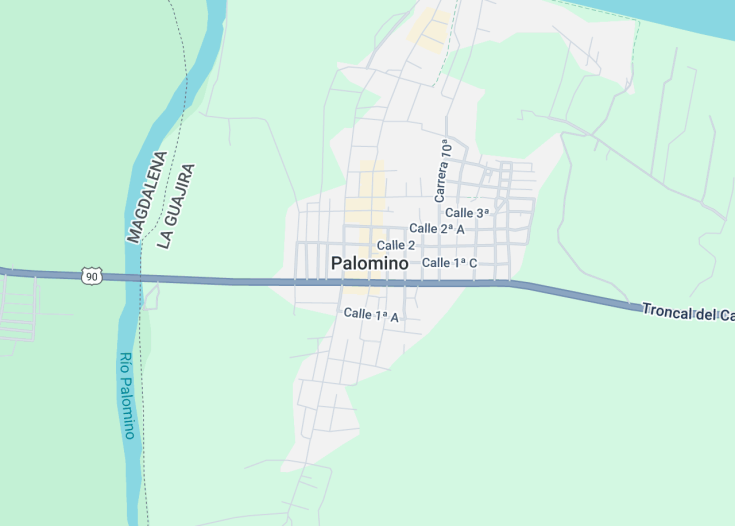Nestled between the verdant Sierra Nevada de Santa Marta and the Caribbean Sea, Palomino offers a unique blend of natural beauty and serene ambiance. Renowned for its stunning beaches, lush tropical scenery, and rich indigenous heritage, this picturesque village is a haven for eco-tourists and adventure seekers alike.
The vibrant local culture, coupled with the area’s biodiversity, makes Palomino a compelling destination for those drawn to nature and exploration.
For the best experience in Palomino, consider visiting from December to April. During these months, the weather is most favorable, enhancing your beach and hiking activities.
Explore beyond the beaches; take a guided tour to discover the local flora and fauna. It’s a remarkable way to connect with the natural beauty and cultural heart of Palomino.
Top things to do & see in Palomino
Select the following sights and activities to discover best tickets and tours available in Palomino.
Palomino: A Coastal Haven in Colombia
| Country | Colombia |
| Time in Palomino | GMT-5 |
| Language spoken | Spanish |
| Population | Approximately 4,300 (Source: local census 2021) |
| Currency | Colombian Peso (COP, $) |
| Airports |
|
Palomino is a serene coastal village in the department of La Guajira, Colombia, cherished for its beautiful sandy beaches and the unique convergence of the Palomino River into the Caribbean Sea. Surrounded by the Sierra Nevada mountains, this locale offers a scenic blend of tropical forest and sea coasts.
Historically, Palomino was inhabited by indigenous communities, and today it remains a testament to the rich cultural tapestry of Colombia, combining traditional lore with eco-tourism and adventure sports. Its tranquil environment, contrasted with adventure tourism like river tubing and trekking, attracts visitors seeking both relaxation and excitement.
Where is Palomino?
Located on Colombia’s northern Caribbean coast, Palomino is part of the La Guajira region.
Distances:
| Route | Distance by car | Time by car |
|---|---|---|
| Santa Marta to Palomino | 55 miles (88.5 km) | 1 hour 30 minutes |
| Barranquilla to Palomino | 100 miles (161 km) | 3 hours |
| Bogotá to Palomino | 585 miles (941.5 km) | 13 hours |
What is Palomino famous for?
Palomino is renowned for its pristine beaches, the backdrop of the Sierra Nevada peaks, and its unique offering of river tubing down the Palomino River, an exhilarating experience that blends adventure with natural beauty.
History
In the verdant landscapes of Colombia, the coastal village of Palomino stands out not just for its natural beauty, but also for its rich tapestry of history that stretches back to ancient times. Palomino’s story is characterized by a sequence of cultural and historical shifts, from its indigenous roots to its role in modern Colombian tourism.
Pre-Colombian Period – Before 1500
The area that is now Palomino was originally inhabited by the indigenous Tairona people, skilled in crafting, agriculture, and trade. They utilized the rich natural resources of the region and developed complex socio-political structures long before European contact. The Tairona culture is particularly noted for its intricate goldwork and pottery, which reflect a sophisticated understanding of their environment and beliefs.
Spanish Conquest and Colonial Era – 1500-1810
With the arrival of the Spanish in the early 16th century, Palomino underwent significant changes. The indigenous populations faced conquest and colonization, leading to a dramatic shift in their cultural and social fabric. The Spanish established control over the region, which they used primarily as a strategic location for trade. Over the centuries, Palomino and the surrounding areas were influenced by European administrative policies and Catholic missionary efforts, which introduced new agricultural practices and religious customs.
The Republican Era to Modern Day – 1810-Present
Following Colombia’s independence from Spain in 1810, Palomino began a gradual transformation into a more integrated part of the national economy. In the 20th century, the region’s pristine natural environment and strategic location made it a focal point for both local and international tourism. Today, Palomino is recognized for its picturesque beaches and as a hub for ecotourism and adventure sports, preserving both its natural beauty and historical heritage.
Visit Palomino
What to see and do in Palomino
Palomino offers a unique blend of historical richness and natural beauty that provides visitors with a plethora of activities and sights. Explore the following:
- The pristine beaches of Palomino, ideal for surfing, sunbathing, and enjoying breathtaking sunsets.
- The Palomino River, perfect for river tubing, a popular activity that offers a relaxing way to enjoy the natural surroundings.
- Guided tours to discover the flora and fauna of the nearby Sierra Nevada, where visitors can also learn about the indigenous communities that inhabit the region.
- Visits to archaeological sites left by the Tairona culture, offering insights into the ancient inhabitants of the area.
Festivals and Celebrations in Palomino
Palomino hosts several cultural and ecological festivals throughout the year, celebrating its indigenous heritage and lush landscape. Notable events include the Palomino Cultural Festival in the summer, which showcases traditional music, dance, and crafts.
Additionally, the annual Sea Turtle Festival in the autumn raises awareness and promotes conservation of local wildlife.
Best time to visit Palomino
The optimal time to visit Palomino is between December and April. During these months, the weather is most favorable, with less rainfall and clearer skies, making it ideal for outdoor activities and exploring the natural attractions.
Is Palomino worth visiting?
Palomino is undoubtedly worth visiting for those who seek a combination of ecological adventures and cultural immersion.
Its unique location at the foot of the Sierra Nevada, coupled with its rich historical background and vibrant local culture, makes it a compelling destination for travelers interested in more than just the typical tourist spots.










